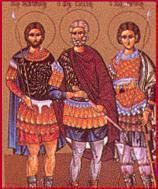Died 304Tarsus, Asia Minor Role Martyr | Name Andronicus, and Canonized Pre-congregation | |
 | ||
Attributes Tarachus is depicted as an elderly man, in the robes of a Roman citizen, with a spear. The others are depicted with crosses or spears. | ||
Saints Andronicus, Probus (Provos), and Tarachus (Tharacus, Tarachos) were martyrs of the Diocletian persecution (about 304 AD). The Martyrologium Hieronymianum contains the names of these three martyrs on four different days (the four days 8–11 October evidently signify no more than the date on a single day), with the topographical identification: In Tarso Cilicie, on September 27 (ed. De Rossi-Duchesne, 126), to which corresponds the expression, In Cilicia, given on the two days of 5 April, and 8–11 October. The expression, In Palestina, given under 13 May (ibid., 60), is either an error or refers to a special shrine of the martyrs in Palestine.
There are two accounts of their martyrdom, the first account being held by Thierry Ruinart (Acta Martyrum, ed. Ratisbon, 448 sq.) to be entirely authentic. According to these Acts, Tarachus (ca. 239- 304), a Roman who was a native of Claudiopolis in Isauria and a former soldier, the plebeian Probus of Side in Pamphylia, and the patrician Andronicus, who belonged to a prominent family of Ephesus, were tried by the governor Numerian Maximus and horribly tortured three times in various cities, including Tarsus, Mopsuestia, and Anazarbus of Cilicia.
According to tradition, Tarachus was beaten on his cheeks and neck with stones. His hands were also burned. He was hanged on a post and smoke was put underneath him to choke him; vinegar was forced down his nostrils; after enduring further tortures, he was carved to pieces. Probus was thrashed with whips, his feet were burned with red hot irons, his back and sides were pierced with heated spits; finally he also was cut up with knives. Andronicus was also cut to pieces with knives.
They were then condemned to death by wild beasts, and when the animals would not touch them in the amphitheatre they were put to death with the sword. Harnack, however, expressed doubts as to the genuineness of the account (Geschichte der altchristlichen Literatur, pt. II: Die Chronologie, I, 479 sq., note 5), and Hippolyte Delehaye (Les légendes hagiographiques, 135 sq.) puts the martyrdom in the class of legends of martyrs that he calls "historical romances". Three men, named Marcian, Felix, and Verus, witnessed their martyrdom and added an epilogue to the saints' Acts. They retrieved the bodies of the three saints, buried them, and watched over them the rest of their lives, requesting that they be buried in the same vault as the martyrs at the end of theirs.
Their feast is celebrated in the Roman Catholic Church on October 11, and in the Greek Orthodox Church on October 12.
